Tomatoes
Remove tomato flowers: For the biggest juiciest tomatoes you should remove flowers until the plants are 12-18″ tall so that the plants can direct more energy to their roots.
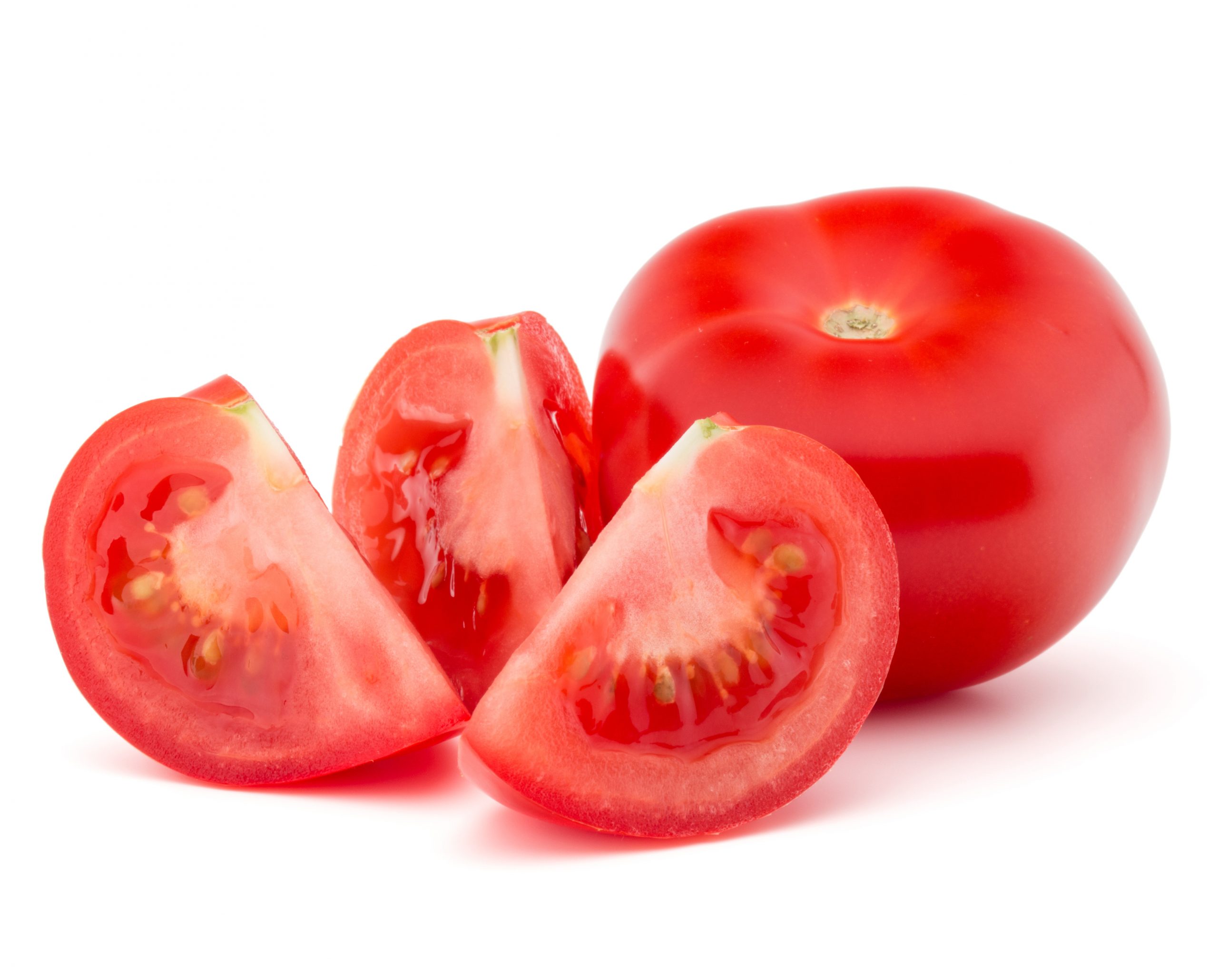
Be Creative, Be Inspired, Be Selective | M-F: 9-6, Sat: 9-5 | 937-845-0093
Summer is well and truly underway and tender plants such as tomatoes, courgettes, and peppers are putting down roots and growing away speedily. Here are some ideas to help them survive the summer.
Remove tomato flowers: For the biggest juiciest tomatoes you should remove flowers until the plants are 12-18″ tall so that the plants can direct more energy to their roots.


Pruning can help create healthier, more productive tomato plants. As a rule, pruning is most helpful for indeterminate tomato varieties. Determinate tomato plants are those that grow to a predetermined size, produce a crop of fruit, and then die. Indeterminate tomato plants continue to grow, producing new stems and fruit through the end of the season.
Tomato suckers, also known as side shoots, appear in the crotch between the stem and a branch. It is important to trim away these suckers early on as they compete with the main stem for nutrients. To remove a sucker, grab the tip between your thumb and forefinger and bend it back and forth until it snaps. Stems that are thicker in diameter than a pencil should be removed with clean and sharp snippers.
Letting tomatoes grow along the ground invites diseases, and the fruits may rot if they are lying on wet earth.
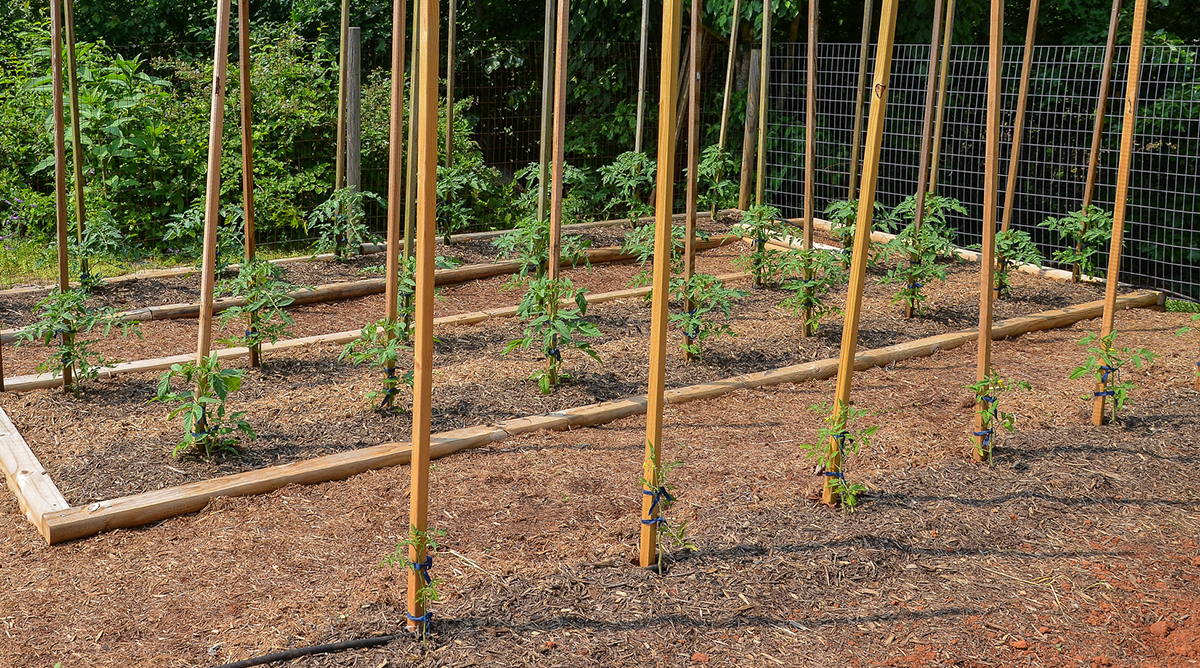
A tomato cage is probably the most common way to stake tomatoes off the ground. Tomato cages allow the plant to grow upwards. The heavy fruiting branches need support, and a bountiful harvest can be ruined with rot or disease if tomatoes are overcrowded, drooping, or forming on the ground. Without a cage, the plant can topple over or break completely under its own weight.
After you first plant your tomato plants, you need to place a tomato cage around them. Setting the cage early will allow the tomato’s roots to grow uninterrupted. Placing the cage in the soil when the plant has matured can damage the tomatoes, the roots, and vines.
Properly anchoring your tomato cage in the soil requires a bit of pressure. Cone-shaped tomato cages are installed with the narrow end at the bottom. The cage legs should be at least 6 inches in the soil to ensure that the cage is secure.
After the cage is securely placed around the young tomato, gently guide the tomato vines through the cage as they grow. As the tomato grows, continue to secure the foliage and its vines through the cage bars, taking special care not to remove any blooms and small, green tomatoes. Use soft twine, yarn, or string to tie and direct heavier branches onto the cage.
For plants growing four feet or less, simply insert a bamboo cane or 36-48″ wooden stake ten inches into the soil, just outside the diameter of the root ball. Do this when planted initially, as it’s easier when the tomato is young and small to avoid damaging the roots. When the plant reaches 12″ in height, loosely tie the stem to the supporting stake using natural, degradable twine or upcycled strips of t-shirts or hosiery. As it grows, repeat ties every 8-12″ for best results.
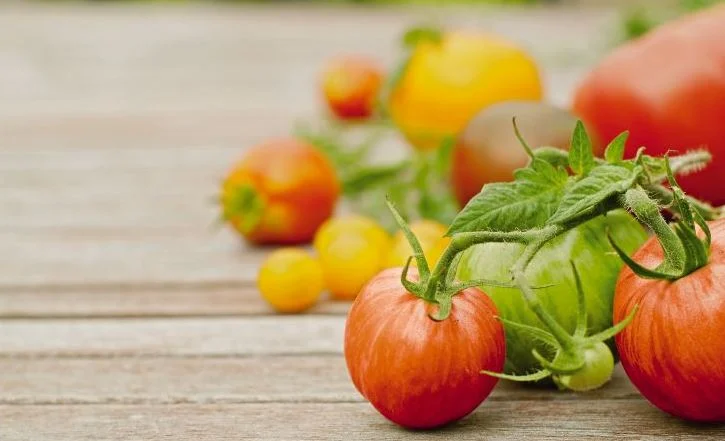
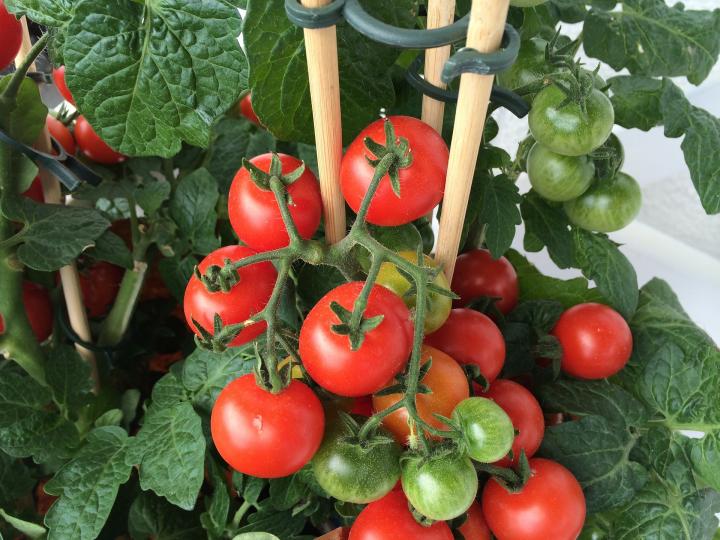
For plants growing four feet or larger, it’s a safe bet to support with a sturdy cage or trellis. Create circular cages with rolls of livestock fencing or concrete reinforcing wire cut into six-foot lengths, bending the cut wires together to securely fasten the cylindrical shape. Place this over the young tomato plant, securing with two wooden stakes driven into the soil and tied to the cage. No matter your method, the key is keeping the branches off of the ground and upright, supporting the weight of the fruit.
Drive a 4-5′ stake between every other plant in a row, then tightly tie twine to the first stake about 12″ from the soil line.
Run the length of twine by the first tomato, in-between the two plants, then around the second stake in a figure-eight pattern.
Tie off the twine when returning to the first stake so that there is good tension for supporting the plants.
As the plants grow, twine is added at 12 -18″ intervals up the stakes.
Tuck in wayward stems to keep them tidily behind twine.

Excessive heat can lead to cucumber plant collapse, though more than likely, it will just reduce the yield of the plants, which can be a pain when you put a lot of effort into growing them. Luckily, there are some easy steps available for those who are looking to grow these plants.
Cucumbers grow best in loose, fertile soil that is acidic, well-drained, and organically rich. They are regularly grown in cages, on trellises, or on the ground if there is enough space. They can be started outdoors in the garden after the last frost date of the year, or you can start them indoors four to six weeks prior to the last spring frost date.
The ideal cucumber growing temperature is between 50 and 95 degrees Fahrenheit. Temperatures below 50 degrees will cause them to grow slower, as will temperatures above 95 degrees.
Shading techniques can effectively lower the temperature for plants like cucumbers. There are several different ways that this can be accomplished. Start by gathering plant stakes and some kind of shade cloth. A similar technique can be achieved by using garden umbrellas, and a laundry basket flipped upside down can also be used if the plants are small enough.
If the heat is particularly bad, keep a close eye on the soil moisture. Attempt to keep the soil around the cucumbers evenly moist; no deeper than 2 to 3 inches should be dry. When the soil becomes dry to 4 inches or more, give the plants a deep watering.
You can also keep your soil temperature down and slow evaporation during hot days by mulching. Place a layer of 2 to 3 inches of dried leaves or compost around the plants.
Growing peppers is easy in any sunny, well-drained spot, and they are good candidates for roomy containers. All peppers share a preference for a long, warm growing season.
As summer arrives, water consistently, but keep in mind that hot peppers generally prefer drier soil conditions. Water when the soil is dry an inch or two down and be sure to water the soil, not the pepper plant. Wet foliage can spread disease.
Pepper plants need good drainage too and do well in a raised bed. If your summer months see a lot of rain, this is a setup worth looking into.
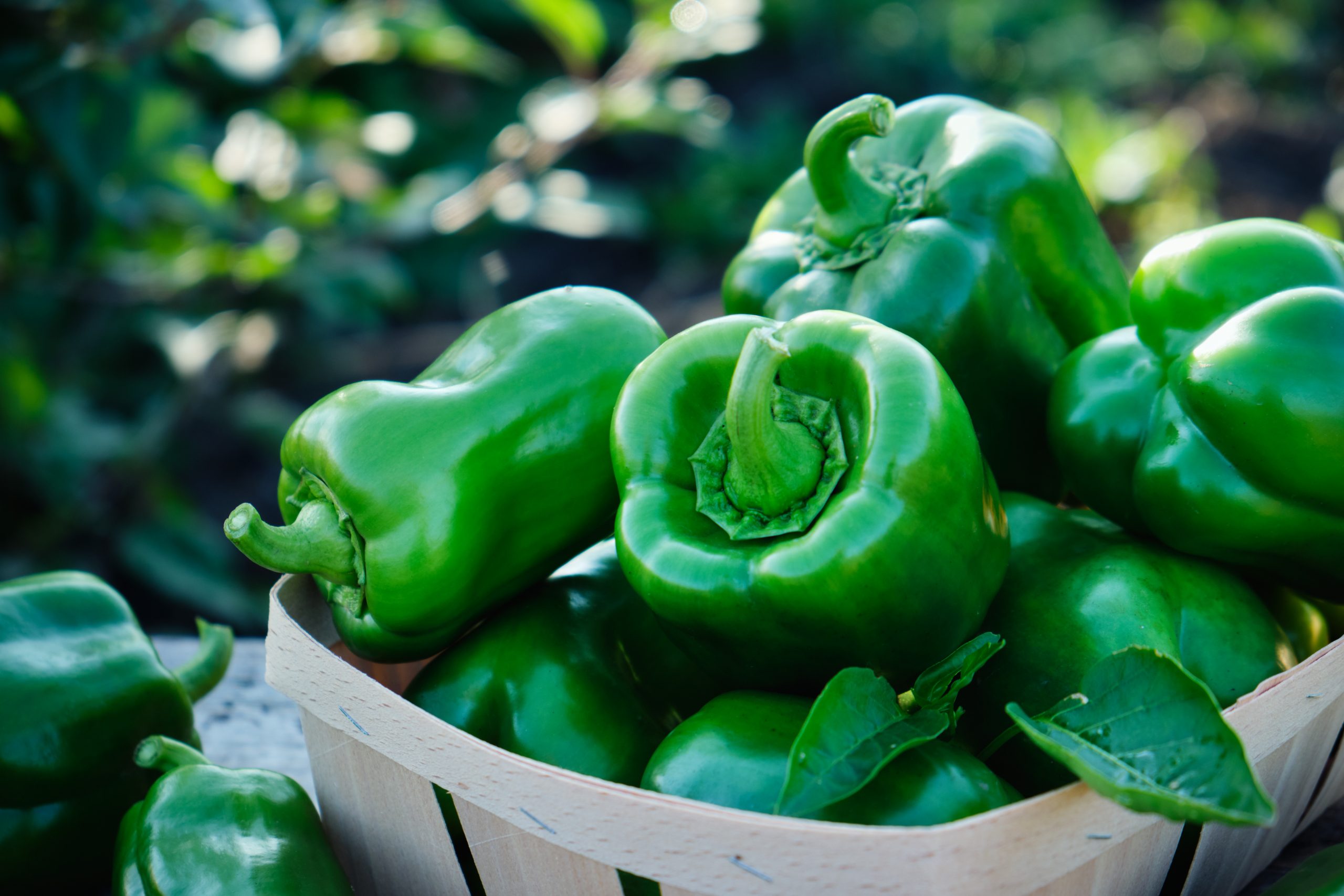

Spreading mulch can safeguard against insects while keeping the soil warm and helping with drainage. Don’t be surprised if blossom end rot takes hold if the soil around your pepper plants gets waterlogged.
Fertilize hot peppers several times during the growing season with an all-purpose liquid organic vegetable or tomato fertilizer to give them a boost.
Avoid high-nitrogen fertilizer which promotes foliage growth but can reduce fruit production.
Support each pepper plant with a stake or small tomato cage, to help bear the weight of the fruit once it begins to produce.
Gardeners in hot climates may need to be patient with big bells and sweet roasting peppers, which often wait until nights become longer and cooler in late summer to load up with fruit. The wait will go by faster if you have less flashy banana peppers to combine with tomatoes and basil in cool summer salads while bigger varieties slowly load up with fruits.
Peppers, like tomatoes and other veggies, require nitrogen for robust plant growth, phosphorus for increasing the plant’s ability to store energy, and potassium to help the plant resist disease. Depending on the soil content, peppers also might need a fertilizer that contains calcium, magnesium, or iron.
First, broadcast the soil with Bio-tone Starter fertilizer, Bumper Crop Soil Builder, or compost before you put any plants in the ground. Then, front load the plants with nitrogen for optimal growth. Adding the right amount of nitrogen will stimulate stem and foliage growth so that your pepper plants will grow big enough to support several fruits each.
| Cookie | Duration | Description |
|---|---|---|
| cookielawinfo-checkbox-analytics | 11 months | This cookie is set by GDPR Cookie Consent plugin. The cookie is used to store the user consent for the cookies in the category "Analytics". |
| cookielawinfo-checkbox-functional | 11 months | The cookie is set by GDPR cookie consent to record the user consent for the cookies in the category "Functional". |
| cookielawinfo-checkbox-necessary | 11 months | This cookie is set by GDPR Cookie Consent plugin. The cookies is used to store the user consent for the cookies in the category "Necessary". |
| cookielawinfo-checkbox-others | 11 months | This cookie is set by GDPR Cookie Consent plugin. The cookie is used to store the user consent for the cookies in the category "Other. |
| cookielawinfo-checkbox-performance | 11 months | This cookie is set by GDPR Cookie Consent plugin. The cookie is used to store the user consent for the cookies in the category "Performance". |
| viewed_cookie_policy | 11 months | The cookie is set by the GDPR Cookie Consent plugin and is used to store whether or not user has consented to the use of cookies. It does not store any personal data. |